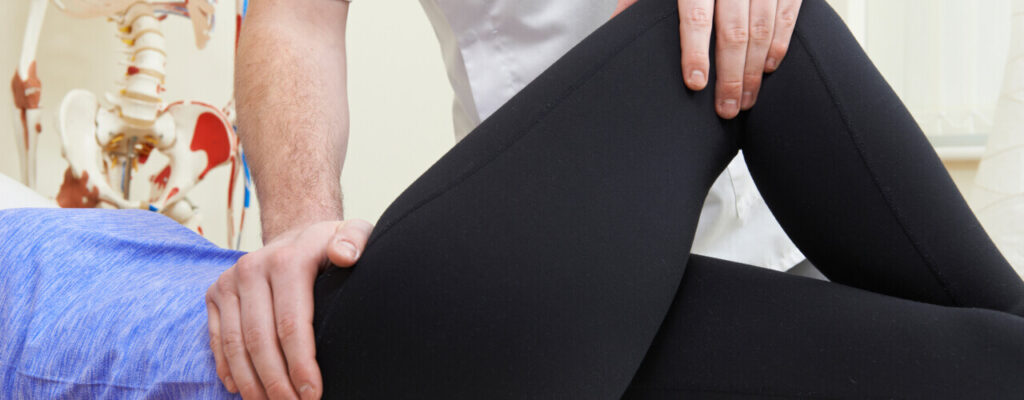Hip and Knee Pain Getting You Down? Physiotherapy Can Help

Move with Ease Once Again!
Hip and knee pain can be difficult to live with. According to the Choosing Wisely Canada site, “Osteoarthritis is the most common type of arthritis, affecting 1 in 10 Canadian adults The knee is one of the most common and most symptomatically affected joints, causing knee pain in many people. They often try over-the-counter remedies to help the pain, and to avoid knee surgery.”
Are you struggling with debilitating or uncomfortable pain in your knees or hips? If so, physiotherapy can help.
The knees and hips are important, complex areas of the body. There are several tendons, joints, and muscles that are joined together in these parts of your body, and they help you to move in normal ways.
However, if these areas are damaged at all, or if you’re feeling pain in them, it can become very difficult to do the things you normally do.
Thankfully, physiotherapy can help relieve knee and hip pain! Contact our office to learn more about how a trained physiotherapist can help give you the long-lasting pain relief you deserve.
How will physiotherapy benefit me?
Your pain might feel overwhelming, but no matter what condition you’re suffering from, a physiotherapist can help relieve your pain.
Your movement specialist will assess your condition, medical history, and pain levels to create a specialized program that meets your exact needs.
Read on to learn more about treatment methods a physiotherapist might use to reduce and relieve hip and knee pain.
- At-Home Exercises – Did you know you don’t always have to be in a clinical setting to do physiotherapy exercises? It’s true! Physiotherapy techniques can be incorporated into a home exercise program that can become part of your daily routine.
- Ice & Heat – A physiotherapist may use ice packs to reduce swelling and inflammation. Heat is also commonly used during physiotherapy to help increase mobility and reduce pain.
- Manual Physiotherapy – Hands-on techniques are used often in physiotherapy to reduce pain in your hips and knees. This could include stretching exercises or a variety of massage techniques.
- Laser Therapy – Laser therapy has become much more popular in physiotherapy for pain management. It can help improve the growth and reproduction of cells, increase circulation, and also reduce inflammation.
- Ultrasound Therapy – Ultrasound therapy can be used in physiotherapy to provide soothing heat to deep tissues. A licensed physiotherapist can also utilize ultrasound technology to easily identify specific areas of pain.
Another great treatment available as part of full exercise program by your physiotherapist, is dry needling. Check out this video to learn more:
Do you have one of these conditions?
There are many kinds of conditions that can negatively affect the movement of your knees and hips.
These issues occur because of traumatic injury, chronic disease, or repetitive motions you do with a job, sport, or hobby.
- Arthritis – Arthritis, or “osteoarthritis” is a condition where tissues around the joints become inflamed and irritated. i This condition can cause pain in a number of places all over your body, including your hands, knees, and hips. A physiotherapist can teach you correct posture and proper movement techniques to protect your joints and prevent your arthritis from taking over your normal day to day activities.
- Bursitis – Bursitis occurs when a small sac of fluid known as the “bursa” becomes painfully inflamed. This is brought on by overuse or repetitive injuries, similar to many other conditions. Bursitis can occur in a variety of locations in the body including the elbows, knees and hips. Physiotherapy reduces pain with bursitis and helps with speedy recovery timelines.
- Strains and sprains – Strains and sprains are common injuries, but come about in different ways. Strains happen when a muscle or tendon is overstretched or torn. A sprain is a stretched or torn ligament. Ligaments can even rupture, which results in bruising, limited mobility, and pain. A physiotherapist can show you exercises to help you recover more quickly. They can also teach you ways to move in order to reduce further pain or injuries.
- Tears in the meniscus – Unfortunately, meniscus tears are one of the more common knee injuries people experience. This injury causes swelling, stiffness, and varying degrees of pain. You’re also at a higher risk for receiving this energy if you’re engaging in aggressive pivoting and twisting of your legs. Athletes experience tears often because of this. A physiotherapist can provide safe and effective treatment for a torn meniscus – without surgery!
Don’t let yourself live in pain any longer!
Ready to get started on the path toward relief? Find out today how physiotherapy can reduce or even eliminate your knee or hip pain.
Your physiotherapist can conduct a thorough examination of your body, pinpoint the areas in your hips and knees where you’re struggling with pain, and create a customized program to treat your particular condition.
You deserve to get back to the activities you love without feeling as if your hips and knees will limit you. You can find relief with one of our highly experienced physiotherapists, so what are you waiting for?
Contact SOS Physiotherapy to schedule your one-on-one evaluation today, and get back on the road to recovery.

